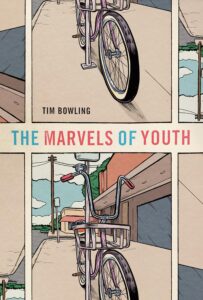Remembrance of Ladner past
The Marvels of Youth
by Tim Bowling
Hamilton: Wolsak and Wynn, 2023
$24.00 / 9781989496749
Reviewed by Theo Dombrowski
*

“So we beat on, boats against the current, borne back ceaselessly into the past.” With this ineffably poignant sentence Scott F. Fitzgerald concludes his landmark novel, The Great Gatsby.
Both for what it says and equally for how it says it, this sentence seems to haunt The Marvels of Youth by award-winning Vancouver-born Edmontonian Tim Bowling (The Tinsmith). In many ways, in fact, the novel articulates the essence of this time-and-pain-laced story of distant youth: looking back on his boyhood from the perspective of a man in his sixties, the narrator of the novel reflects, “My story doesn’t have its origins in words and pictures but … in the seasons and the creatures of the one vanished world, vital and glorious in the senses, overshadowed by suffering, loneliness and war.”
As even this single sentence demonstrates a remarkable feature of this novel is its handling of language. Bowling is a master in casting a luminescent veil of words over even the most mundane realities, often stirring echoes of Dylan Thomas in both style and sentiment:
In the last heat and light of a long summer day, I shivered with a knowledge that never fully reached me, until Keith’s voice tore the gossamer between the worlds and the two figures descended into the tall grass shimmering like the sea around their sorrow-anchored house.
The rich overflow of figurative language (much of it based on the salmon that teem in the adjacent Fraser River), compound descriptors, and complex sentences creates an almost hallucinatory sensory and emotional vision. And to add to the impact, Bowling allows his most telling sentences to linger in a minor key long after a chapter ends.
Yet, through this glowing language, Bowling tells a simple story. A man recalls one year of his boyhood in a small salmon fishing town (corresponding to Ladner) near the mouth of the Fraser River.
Then, his life involved little more than delivering newspapers, mooching around a comic book store, and helping his father with his gill netting. Several events, however, deeply affected him. One was the deepening crisis around a fishermen’s strike against exploitative canneries. Another, more personal, was the confusion and anxiety he suffered from having been a shocked and unwilling witness to an illicit act—and with no idea how to handle the knowledge.
By the novel’s end, loss, failure, and shifting relationships drain the spirit out of his town and his own spirit. Buildings disappear, a family moves away, and the much anticipated salmon run ends in disappointment and decay.
As much as Marvels captures remembered events, though, it’s also a novel about a riverside town’s moment in history: “Just like the great white shark in Jaws, time had to keep moving, despite the static hands on the face of our town clock, in order to stay alive.” The reference to Jaws is doubly significant: the popular American culture of movies, comics, and television is inescapable. Bowling’s accounts of the 1970s is veined with the lingering effects of the Second World War: “war has scarred both the women and men in deep and unbidden ways” leaving “unspeakable losses and suffering.” And, as an emblem of that conflict, into this town wanders an American draft dodger, a fugitive from another, terrible war.
In many ways Marvels tells a social history—but one which is felt rather than merely recorded. The season of gill netting, for example, though meticulously documented, seems both visceral and ritualistic. Likewise, the poverty of the protagonist’s family, more than about shortage, is about interior damage. Sean’s mother explains, “You see, it’s what having so little does to you. You begin to believe that anything good just can’t last.” Even the fishermen’s strike, as the adult protagonist reflects later, cut through the fabric of the town as it could only in the ’70s: “The world [of strikes] … has largely gone,” he says of the 2020s, and adds sharply, “especially in a place like Alberta, which generally caters to corporations.”
The social history surrounding the protagonist’s most intense experience, namely comic books, might seem comparatively superficial. While, however, the author records much about the culture of trading and investing in comic books, he penetrates far below the surfaces. Thus, comic maestro Jack Kirby, the protagonist’s favourite artist, he reveals to give voice to deeply human values. Especially in his superhero stories for Marvel comics (evoked by the novel’s title), Kirby “understood in his core that the battle for justice, for good to triumph over evil, was a permanent battle.” And further: “what defined a person was his willingness to take up the fight.”
Even more than a social history, though, Bowling makes Marvels about the immeasurable.

Above all, his novel is permeated by the town’s subliminal connection with the river: “Something as great and mysterious as the river itself had pervaded the morning, something that could be sensed but not comprehended.” Over and again, Bowling creates moments that can be “sensed but not comprehended.” Two almost visionary encounters with a giant sturgeon, for instance, resonate far beyond the facts.
Likewise, the weather is as evocative as the river: shrouded in autumn fogs and incessant rain, the novel begins and ends in November—“the cruellest month,” as the narrator says, modifying T.S. Eliot’s famous phrase. All is dark, bleak, and decaying. Rain and fog subsume and obscure everything. Between the two autumns, though, a brutally hot summer descends, its very heat assaulting the protagonist: “Dull blow by blow, the summer was building a gallows.”
Add to the weather the smells—smells intermixed with every moment and season. During the dark autumn, the “smell of rotted pumpkin, engine grease and stale fish slime drifted in gusts off the salmon net.” Over the blistering summer these odours are replaced by “the unmistakeable wake of sweat, blood and, now, alcohol that seemed to be a part of the brine and fish slime smell washing over the town from the west, drowning in the softer confections of ripening fruit and pool chlorine.”
With such unforgettable passages Bowling creates a novel of mood and atmosphere as much as of place and time. Of all the phases of recollected mood that colour Marvels, though, the most gnawing for the adult narrator is “nostalgia” for “the vibrant, creative and tragic world I had lost.” More than just nostalgic, though, the tone is powerfully elegiac, evoking as it does “the spiderweb fragility of the dew-stippled still-sleeping town.”
Reinforcing this sense of the past, the narrator recalls changes running through him even without his knowing. Constantly, he uses phrases like “I didn’t know it then,” phrases that are especially affecting when, as in this case, he concludes, “I was also beginning to walk out of one world while another was rapidly receding from me.”
And as powerful as the sense of the past is the sense of time’s passage. The broken town clock that looms over Marvels is a reminder of the very presence of transience, “the present and future swirling ahead of me and the past, no more comforting or certain, conspiring in whispers at my back.”
Clearly, the past is not rose-coloured. On the contrary. One of the extraordinary tacks Bowling takes with his tale is to tap into many of the traditions of so-called “Southern Gothic.”
However far removed the town may be from the American South, the protagonist’s experiences are often strikingly resonant of a storytelling tradition riddled with decay, poverty, a haunting past, grotesque and nightmarish incidents, lurking threat and sudden, twisted violence. The impact is intensified by a specific narrative strategy: though the story is framed by an adult’s memory, Bowling rarely allows the readers a comfortable adult perspective. Instead, he immerses the reader into the quiveringly sharp and often confused terrors of a young boy, where everything “seemed to have been swallowed up whole by the unrelenting darkness.” To create a perfect gothic touch, for example, Bowling leads his protagonist into an “abandoned house, its collapsing verandah and moss-grimed turrets as dark as ever even in the gold summer sunshine.” To boot, says the protagonist, “I sense the ghosts watching me.”
Of the ghoulish events two are especially central to the action and a major character. The first is the protagonist’s bewildered horror at encountering in the dark, by the river, hundreds of inexplicable, glowing, jack o’lanterns, “like some sort of menacing, beheaded army.” The second, even more disquieting, is “the transient image of a man vanishing into fire and smoke and the sound of eerie laughter across water, where phantom boats glide like searching hands.”
Importantly, these last two incidents involve a strange, marginalized man called Edgar Winterbourne. Dressed perpetually in black, he “would appear on the dike or in the streets of town like a scarecrow made animate by a mad scientist—I often heard his cackling laughter even when he wasn’t visible.” Though he may be the most striking outsider character, Edgar is not alone: Bowering peoples Marvels with a tangle of unforgettable figures.
In his characterization, the author reveals real wells of hurt and humanity. Edgar’s story, appearing late in the novel, is the most poignant and, in many ways, underlies the most climactic crisis in the novel. The nightmarish finale of the novel portrays Edgar as a tragically damaged man trapped by his inability to find peace.
Perhaps even more significant to the author’s sense of human nature, is that repeatedly—and movingly—Bowling lifts the shell off even closed characters to show their capacity for quiet compassion and selfless humanity. In doing so, he reveals tremendous depths of still, almost invisible kindness, from Sean’s mother, his (now dead) grandmother, his father, and, crucially, the avuncular and reflective Mr. Edison, who owns the comic book store. In addition, as the protagonist states, in spite of the “heavy shadow of pain, suffering and war” he has witnessed “also the quieter presence of courage, perseverance and dignity.”
And, remarkably, Bowling has placed all the weight of his vision of humanity on the shoulders of an apprehensive ten year old boy. From the outset, Sean—or “Monk”—is strikingly sensitive to impressions and emotions. The author has created through this vulnerable and often frightened boy an insightful witness of the painful events in the town. Even as an adult looking back on his childhood self, he underplays his own essential goodness—what Mr. Edison, from an outside perspective, sees as “humility and stillness.”
In fact, it is almost endearing that Sean can accuse himself, in retrospect, of acting “petulantly, self-righteously” because, to the reader, he was clearly reacting with a child’s hurt. It seems entirely fitting, therefore, that the often overwhelmed and uncertain boy turns into a modest man with a strong moral sense: he lets slip, almost diffidently, that he has become a “teaching aide for special needs children.” It is part of the moving conclusion of the novel that Bowling has this solitary man reflect, “Ordinary men like me don’t get talked about much in the world, and for obvious reasons I suppose.”
Like the narrator of Scott Fitzgerald’s novel, “born back ceaselessly to the past,” Sean concludes, “Perhaps all I could do was accept the responsibility of inheriting a human sadness that, despite the best efforts of my parents and those of the trivial and denying world, was as inevitable as breathing.” Like so much of The Marvels of Youth, his words linger long after the last page.
*

Born on Vancouver Island, Theo Dombrowski grew up in Port Alberni and studied at UVic and later in Nova Scotia and London, England. With a doctorate in English literature, he returned to teach at Royal Roads, UVic, and finally Lester Pearson College in Metchosin. He also studied painting and drawing at Banff School of Fine Arts and UVic. He lives at Nanoose Bay. Visit his website here. [Editor’s note: Theo Dombrowski has written and illustrated several coastal walking and hiking guides, including Secret Beaches of the Salish Sea (Heritage House, 2012), Seaside Walks of Vancouver Island (Rocky Mountain Books, 2016), and Family Walks and Hikes of Vancouver Island (RMB, 2018, reviewed by Chris Fink-Jensen), as well as When Baby Boomers Retire. He has reviewed books by Lisa Brideau, Brady Marks and Mark Timmings, Darrel J. McLeod, Max Wyman, Dustin Cole, Deborah Willis, Lindsay Wong, and Bill Engleson for BCR.]
*
The British Columbia Review
Interim Editors, 2023-25: Trevor Marc Hughes (nonfiction), Brett Josef Grubisic (fiction)
Publisher: Richard Mackie
Formerly The Ormsby Review, The British Columbia Review is an online book review and journal service for BC writers and readers. The Advisory Board now consists of Jean Barman, Wade Davis, Robin Fisher, Barry Gough, Hugh Johnston, Kathy Mezei, Patricia Roy, Maria Tippett, and Graeme Wynn. Provincial Government Patron (since September 2018): Creative BC. Honorary Patron: Yosef Wosk. Scholarly Patron: SFU Graduate Liberal Studies. The British Columbia Review was founded in 2016 by Richard Mackie and Alan Twigg.
“Only connect.” – E.M. Forster
3 comments on “Remembrance of Ladner past”